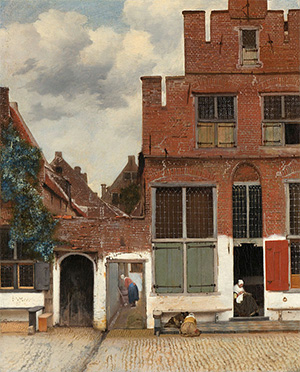Memoir
—after Johannes Vermeer’s painting,
“The Little Street,” c. 1659-1660

It was a summer day. No,
it was all the summer days
in the dog-eared picture book
of memory.
Brick buildings partly shuttered,
blind mullioned windows,
a bright alley to a scullery,
a doorway to the dark.
And Oma mending
with an eye on children playing
sticks and stones on the doorstep tiles.
Mother at the cistern
doing household chores.
Perhaps a cart has just gone by,
wooden wheels trundling the bricks
of the canal bridge. Mute trickle
in the ditch, our own fickle past stirring
behind these bricks and windows
—a sense of “once” in Delft we may recall.
But pause one moment: This
is not a real street, these shutters can’t,
these conflated houses, these people
nobody who ever lived.
Those recessive roofs, that isosceles of sky
and diphthong of passing clouds;
the diminishing size of the windows,
inverted triangle of receding generations?
This is the architecture of remembrance.
Not a portrait of the past
but a notion—fixed and enigmatic.
Tone without plot.
No shadows. No backstory. No next.
We may animate the margins outside
our momentary view with passing barrows,
a coot hen on a nest of sticks
above the lapping water of the canal,
the slopman’s salient voice
and iambic ti-clop of his horse’ hooves.
The arch barking of a dog.
Or fabricate the creaking sails
of a windmill at the heart of town.
But the little street is mute
except for the murmur of our own
receding past, which lingers
like these broken roof tiles, masked
by the whitewash of forgetfulness,
piquant as the point of light in that far facade.
from The Vermeer Suite by Daniel Lusk